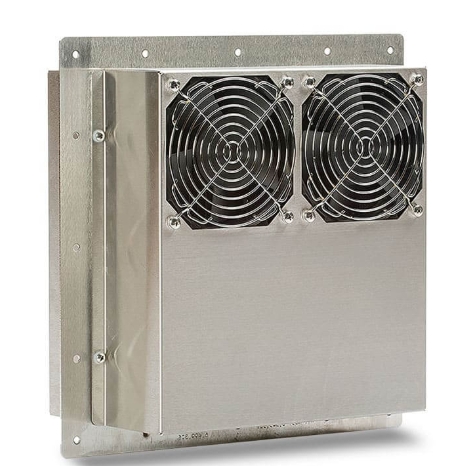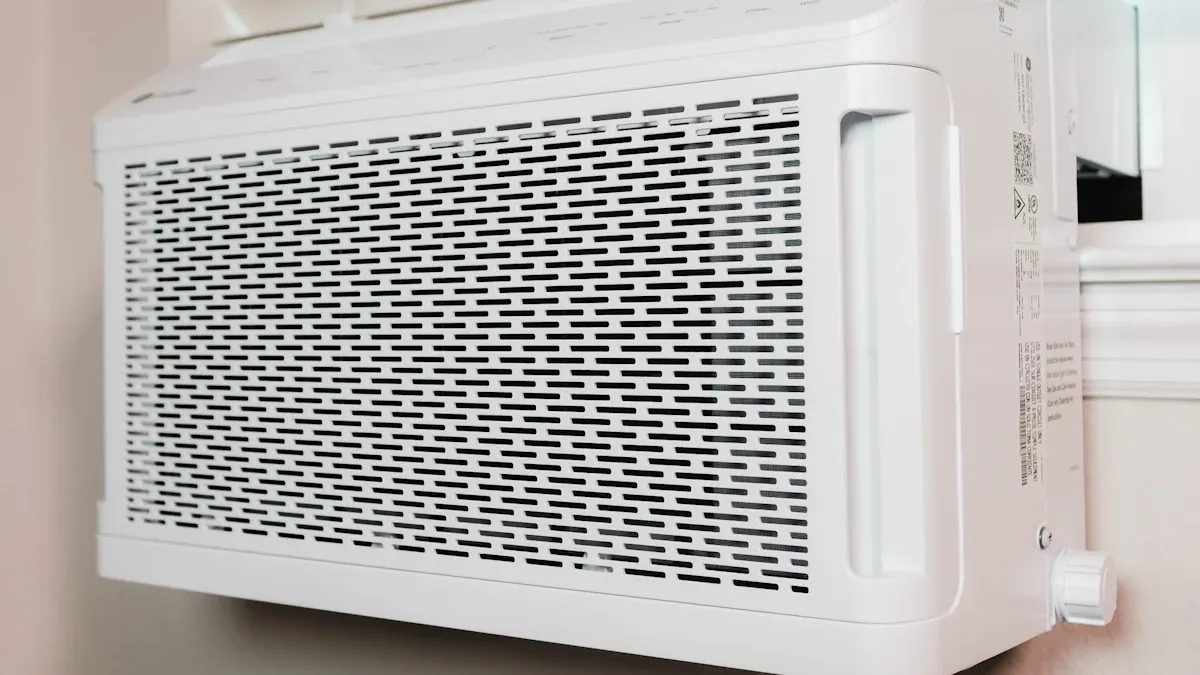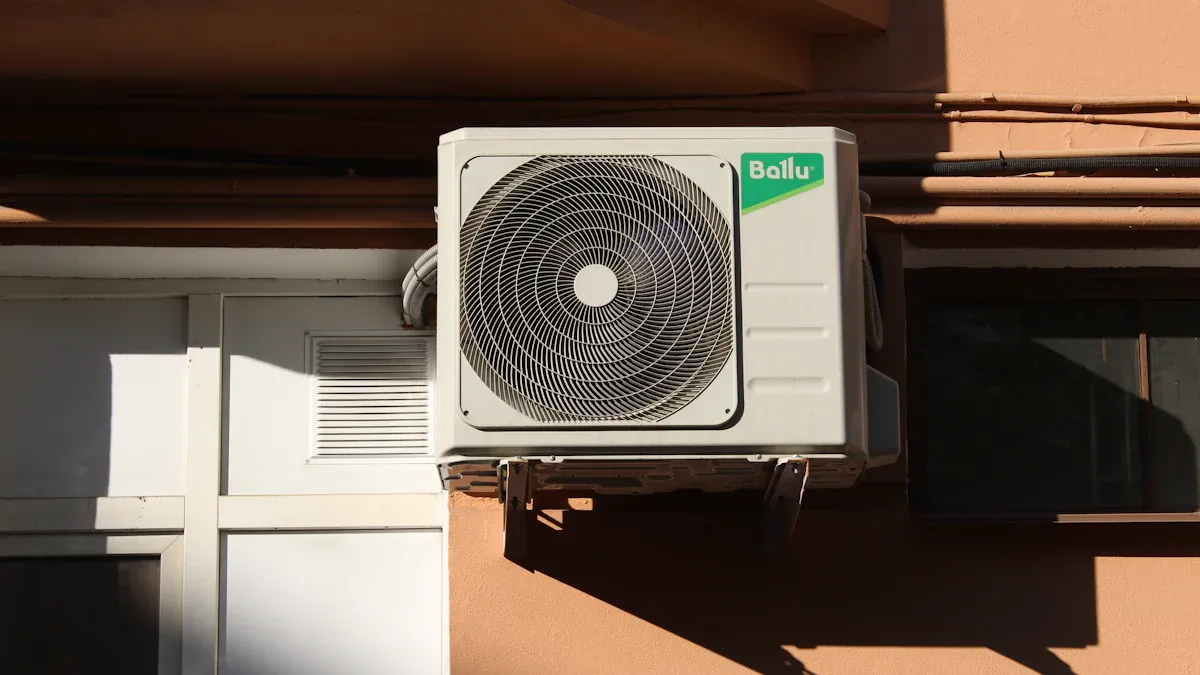How Thermoelectric Air Conditioners Operate and Their Benefits

A thermoelectric air conditioner cools spaces using special technology. It works with the Peltier effect, which moves heat. When electricity flows through a module, heat shifts from one side to the other. One side gets cold, and the other side gives off heat. Unlike regular systems, it has no moving parts or refrigerants. This makes it very efficient.
Thermoelectric air conditioners are great for cooling small or medium spaces. For instance, the TEC-12706 module cools well and costs less to install and maintain than regular systems.
Key Takeaways
Thermoelectric air conditioners cool spaces using the Peltier effect.
They have no moving parts and don’t use harmful chemicals.
These systems need little care, like changing fans every few years.
This saves both your time and money on maintenance.
They are good for the environment and don’t release bad gases.
They use less energy than regular air conditioners, lowering your bills.
Their small size and light weight make them easy to move.
They work well in tight spaces and are simple to install.
These air conditioners give exact temperature control for delicate items.
They are great for medical tools and electronic devices.
What Is a Thermoelectric Air Conditioner?
Overview of Thermoelectric Cooling Technology
Thermoelectric cooling uses the Peltier effect to move heat. Electricity flows through a module, making one side cold and the other hot. This process uses special materials to transfer heat without fluids or moving parts.
Unlike regular systems, thermoelectric cooling can go below room temperature. It avoids leaks since it uses electricity instead of liquids. There’s little upkeep because there are no filters or compressors. New designs are very efficient, with some having a COP over 2.
Principle/Aspect | Description |
|---|---|
Peltier Effect | A solid-state way to move heat using special materials. |
System Design | Closed systems with no air exchange for better cooling. |
Efficiency | Some systems have a COP over 2, showing high efficiency. |
Applications | Used in small spaces or larger areas needing precise cooling. |
Maintenance | Almost no maintenance due to no moving parts or fluids. |
Recent Innovations | New designs save energy and cool up to half a ton. |
Heating Capability | Can heat by reversing polarity, making them more efficient. |
Key Components and Design of Thermoelectric Air Conditioners
Thermoelectric air conditioners have parts that work together for cooling. The Peltier module is the main part, using materials to move heat. Heat sinks and fans remove heat from the hot side, keeping it working well.
Modern systems are closed, stopping air exchange and improving cooling. They need no maintenance since they lack filters, compressors, or fluids. Some can heat and cool by switching polarity. They also come in different styles, fitting various spaces and airflow needs.
Key Component/Innovation | Description |
|---|---|
Peltier Effect | Moves heat using special materials, replacing refrigerants. |
Closed System | No air exchange, improving cooling and efficiency. |
Maintenance-Free | No filters or compressors, so less upkeep is needed. |
Cooling Capacity | Can cool up to half a ton, better than older models. |
Energy Efficiency | Includes energy-saving modes for low-demand times. |
Dual Functionality | Can heat and cool by switching polarity, boosting efficiency. |
Input Voltage Options | Different voltages affect cooling power and energy use. |
Mounting Styles | Various designs fit different spaces and airflow needs. |
How Thermoelectric Air Conditioners Differ from Traditional Systems
Thermoelectric air conditioners are very different from regular ones. Regular systems use fluids and compressors, which can leak and harm the environment. Thermoelectric systems use solid-state technology, making them eco-friendly and cheaper to run.
Tests show thermoelectric systems cool faster. They reached 22℃ in 4 minutes, while regular systems took 20 minutes. They also don’t leak, avoiding refrigerant problems. Their small size and light weight make them great for small spaces or portable uses.
Key Advantages Over Traditional Systems:
No greenhouse gas emissions.
Faster cooling times.
Little maintenance since there are no moving parts.
Cost-effective operation.
Thermoelectric air conditioners are a greener choice. They are efficient, reliable, and better for the planet.
How Thermoelectric Cooling Works

The Peltier effect and its role in cooling
The Peltier effect is key to thermoelectric cooling. When electricity passes through a module, heat moves between sides. One side gets cold, while the other side releases heat. It works like a heat pump but has no moving parts or liquids.
The process depends on materials and electric current. For example, at 0.3 A mm−2, the temperature changes less than 0.1 K in 10 milliseconds. At 1.5 A mm−2, the change ranges from 0.08 K to 0.34 K. After 0.17 seconds, the temperature difference reaches 4.6 K. These quick changes show how well the Peltier effect cools.
Performance Metric | Value | Description |
|---|---|---|
Coefficient of Performance (COP) | 0.92 | Shows how efficient the air conditioner is under certain conditions. |
Cooling Capacity | 157.0 W | Heat removed from the system at a specific voltage. |
Outlet Air Temperature | 28 °C | Air temperature after passing through the cooling system. |
The Peltier effect helps thermoelectric air conditioners cool spaces fast. It also avoids harmful refrigerants, making it better for the environment.
Heat transfer process in thermoelectric modules
Heat transfer in these modules happens in steps. First, the module absorbs heat from the area being cooled. This heat moves through conduction, convection, and radiation. The Peltier effect then shifts heat from the cold side to the hot side. Heat sinks and fans release the heat into the air.
Thermoelectric modules are carefully designed for heat transfer. They use the Peltier, Seebeck, and Thomson effects for better cooling. Materials like bismuth telluride and lead telluride improve these effects.
Feature | Description |
|---|---|
Heat Transfer Modes | Uses conduction, convection, and radiation for accurate heat movement. |
Thermoelectric Effects | Includes Peltier, Seebeck, and Thomson effects for better performance. |
Thermoelectric cooling is flexible. It’s used in gadgets, electronics, and even space missions. Modules have many thermoelectric legs to boost cooling. This design ensures steady performance in different uses.
Importance of semiconductors in thermoelectric cooling
Semiconductors are vital for thermoelectric cooling. They move energy between materials when temperatures differ. Bismuth telluride is a top semiconductor for this purpose. It has been used in thermoelectric cooling for years.
Thermoelectric coolers have no moving parts, which is a big plus. This makes them quieter, cleaner, and more reliable. They are great for quiet places like hospitals or military tools.
Semiconductors make thermoelectric air conditioners efficient and compact. They also allow precise temperature control, which is important for cooling electronics. These systems are eco-friendly and work well in many settings.
Advantages of Thermoelectric Air Conditioners
Reliability and solid-state design
Thermoelectric air conditioners are very reliable because of their solid-state design. Unlike regular systems, they don’t have moving parts. This means less wear and tear over time. They work well for a long time without breaking down. Their small size and efficiency make them useful for many things. They can cool electronics or keep medical devices at steady temperatures.
Here’s why they are so reliable:
The solid-state cooling market is growing fast with new technology.
These systems control temperature precisely, which is great for critical uses.
Better semiconductor materials have improved performance and lowered costs.
Thermoelectric cooling gives you a strong, long-lasting option. It stays efficient and works well for your needs.
Low maintenance and operational simplicity
Thermoelectric air conditioners are easy to maintain, saving time and money. They don’t need filters, compressors, or refrigerants like regular systems. Usually, the only upkeep is replacing the fan every few years.
Maintenance Aspect | Details |
|---|---|
Main Maintenance Task | Replace the fan every few years |
Cooling Module Durability | Solid-state with over 200,000 hours MTBF |
Maintenance Frequency | Very low, mostly limited to fan service |
These systems need little attention, so you can focus on other things. Their solid-state parts last a long time, with over 200,000 hours between failures. Thermoelectric air conditioners are perfect for places needing simple and reliable cooling.
Environmental benefits, including energy efficiency and no refrigerants
Thermoelectric air conditioners are eco-friendly cooling options. They use the Peltier effect to move heat without harmful refrigerants. This means no greenhouse gases, making them better for the planet.
They also save energy. Thermoelectric systems use less power than regular air conditioners, lowering your energy bills. Their small design reduces waste during production. By choosing thermoelectric cooling, you help the environment and get efficient, reliable cooling.
🌱 Tip: Choose thermoelectric air conditioners to cut your carbon footprint and support green cooling solutions.
Small size and lightweight build
Thermoelectric air conditioners are small and light. This makes them perfect for places where big air conditioners won’t fit. You can put them in small rooms, cabinets, or vehicles without worrying about space.
Their light build makes them easy to move and install. Unlike regular systems with heavy parts, these use solid-state technology. They don’t need big compressors or refrigerants, which lowers their weight. Without these bulky parts, they are also more durable.
Here’s a list of features that make them small and light:
Feature | Description |
|---|---|
Small Size | Fits easily in tight spaces. |
Lightweight Build | Easier to handle and install than regular air conditioners. |
Solid-State Design | Reliable and long-lasting with little upkeep needed. |
No Moving Parts | Less wear and tear, making them last longer. |
No Compressors or Refrigerants | Compact design without heavy or bulky parts. |
NEMA 4X Build | Works indoors and outdoors for more uses. |
Handles High Temperatures | Works in heat up to 140°F, great for many places. |
Flexible Mounting Options | Can be installed through-mount, flush-mount, or recessed-mount. |
Digital Temperature Control | Lets you set the temperature exactly how you want. |
These air conditioners can be mounted in different ways, like through-mount or flush-mount. Their small size doesn’t lower their performance. Many models work well in hot places, making them useful for factories or outdoor areas.
Choosing a thermoelectric air conditioner gives you an easy-to-use cooling option. Its small and light design means you can install it almost anywhere. Plus, its solid-state build ensures it will last a long time.
Applications of Thermoelectric Air Conditioners

Cooling sensitive equipment like electronics and medical devices
Thermoelectric air conditioners are great for cooling delicate items. They keep temperatures steady, which is important for electronics and medical tools. For example, medical storage units use these systems to keep vaccines and medicines safe. Blood testing machines also rely on them to keep samples at the right temperature for accurate results.
The need for thermoelectric cooling is growing fast. By 2031, the market could reach $1.2 billion, growing at 7.9% each year. This shows how important these systems are for healthcare and technology.
Metric | Value |
|---|---|
CAGR | 7.9% |
Market Size by 2031 | USD 1.2 billion |
Thermoelectric air conditioners are very reliable for important tasks. Their solid design ensures they work well, making them a trusted choice for protecting sensitive equipment.
Use in extreme environments, such as space or military operations
Thermoelectric air conditioners work well in tough conditions. Their strong design helps them perform where regular systems fail. For example, they cool equipment in hot, sandy deserts during military missions. They also work in humid places like food factories or fire safety systems in Florida.
These systems are flexible. They handle high heat, making them useful for border sensors and factories. In freezing weather, they can heat and cool outdoor tools like air traffic systems. They also resist damage from harsh chemicals, so they work well in factories and near the ocean.
The thermoelectric cooler market may grow from $569.0 million in 2020 to $1,321.1 million by 2030, thanks to demand in military and industrial fields.
Thermoelectric air conditioners are tough and dependable. They meet the needs of challenging environments with ease.
Portable and small-scale cooling solutions
Thermoelectric air conditioners are perfect for small and portable cooling. Their small size and light weight make them easy to move and set up. For example, the TEC2-25408 model is tiny, measuring just 40 mm x 40 mm x 6.4 mm. It’s great for portable coolers or small spaces.
These systems work really well. A lab-made thermoelectric fridge reached 2.3°C and cost only $49.66. Cooling power increases with more airflow, making them useful for many tasks.
Parameter | Value |
|---|---|
Thermoelectric Model | TEC2-25408 |
Dimensions | 40 mm x 40 mm x 6.4 mm |
Cooling Box Capacity | 22 L |
Input Power Variations | 50.5W, 72.72W, 113.64W |
Achieved Temperatures | 19.98°C to 18.52°C |
Adding a fan can lower the cold side temperature from 25.5°C to -5°C, improving cooling and spreading cold air better.
Thermoelectric air conditioners are efficient and portable. Their small size makes them perfect for personal coolers or special equipment.
Thermoelectric Air Conditioners vs. Traditional Cooling Systems
Comparison with compressor-based systems
Thermoelectric air conditioners have many benefits over compressor systems. They use a solid-state design with no moving parts. This makes them more reliable and easier to care for. Compressor systems need regular servicing because of their mechanical parts.
Advantage | Thermoelectric Air Conditioners | Compressor-Based Systems |
|---|---|---|
Reliability | MTBF > 150,000 hours | MTBF < 100,000 hours |
Maintenance | Almost no maintenance needed | Needs regular servicing |
Environmental Impact | No harmful refrigerants | Uses CFCs, HCFCs, or oils |
Temperature Control | ±0.5°C precision | Fluctuates by several degrees |
Operating Cost | Lower overall cost | Higher long-term expenses |
Thermoelectric systems keep temperatures steady within ±0.5°C. Compressor systems often vary by a few degrees, which can harm sensitive items. Also, thermoelectric units are eco-friendly since they don’t use harmful refrigerants like CFCs or HCFCs.
Advantages over evaporative cooling systems
Evaporative coolers use water to lower temperatures. This doesn’t work well in humid places. Thermoelectric air conditioners work the same in any humidity. They also offer precise temperature control, which is great for stable conditions.
Another benefit is their small size and light weight. Thermoelectric systems are easy to move and install. Evaporative coolers need bigger units and water tanks. Plus, thermoelectric systems don’t add moisture to the air. This is important for cooling electronics or keeping spaces dry.
💡 Tip: For humid or sensitive areas, thermoelectric air conditioners are a smarter choice than evaporative coolers.
Scenarios where thermoelectric cooling excels
Thermoelectric air conditioners are perfect for tasks needing precision and reliability. They are great for cooling medical tools, electronics, and lab equipment. Their steady temperatures keep sensitive items safe and working well.
In tough places like deserts or space, thermoelectric systems work better than others. Their solid-state design lasts longer in harsh conditions. They are also light and easy to install, making them ideal for portable coolers or field gear.
These systems are also quiet, unlike noisy compressor systems. This makes them great for hospitals, offices, or military uses.
🌍 Thermoelectric air conditioners are precise, durable, and eco-friendly, making them useful for many cooling needs.
Thermoelectric air conditioners are reliable, energy-saving, and eco-friendly. Their solid-state design lasts long and needs little care. These systems are great for cooling delicate tools like medical devices and electronics. They also work well in tough conditions, making them perfect for hard tasks.
🌍 Sustainable Choice: Picking thermoelectric cooling helps the planet and gives you efficient, accurate cooling.
Think about thermoelectric air conditioners for your cooling needs. They mix smart design, green benefits, and usefulness to fit your requirements.
FAQ
Why are thermoelectric air conditioners better for the environment?
Thermoelectric air conditioners don’t use harmful gases like CFCs or HCFCs. They use the Peltier effect to move heat with electricity. This lowers greenhouse gases and saves energy, making them eco-friendly.
Can thermoelectric air conditioners cool big areas?
These systems are best for small or medium spaces. Their small size and limited power suit electronics, medical tools, and portable cooling. For bigger spaces, regular systems work better.
How long do thermoelectric air conditioners last?
Thermoelectric air conditioners last a long time because of their solid design. With no moving parts, they don’t wear out easily. Many models work for over 200,000 hours, staying reliable for years.
Are thermoelectric air conditioners loud?
No, they are very quiet. Unlike regular systems with compressors, these have no noisy moving parts. They are great for quiet places like hospitals, offices, or bedrooms.
Do thermoelectric air conditioners need much maintenance?
These systems need very little care. You might only replace the fan every few years. Their solid design means no filters, refrigerants, or compressors, saving you time.
💡 Tip: Clean the heat sinks and fans often for better performance.
See Also
In-Depth Analysis of Eco-Friendly Air Conditioning Units
Benefits of ESTEL Cooling Solutions for Industrial Use
The Role of Air Conditioning in Safeguarding Equipment
CALL US DIRECTLY
86-13752765943
3A-8, SHUIWAN 1979 SQUARE (PHASE II), NO.111, TAIZI ROAD,SHUIWAN COMMUNITY, ZHAOSHANG STREET, NANSHAN DISTRICT, SHENZHEN, GUANGDONG, CHINA

